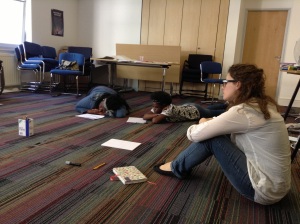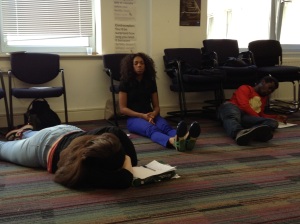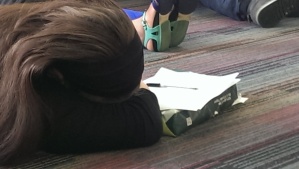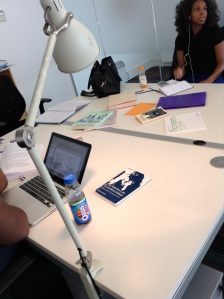This blog is the story of ‘Jessica’ and how interview data has been turned into film. It starts in 2010 with a conversation between a researcher and a 17 year old woman and ends in 2013 with a short film about a young woman and her feelings of desire.
I met 17 year old ‘Jessica’ at a peer educators training session in spring 2010 whilst I was doing my PhD fieldwork in London. She completed a questionnaire and indicated that she would be interested in taking part in a focus group and/or an individual interview as part of my PhD research. I met Jessica again when she attended a focus group organised for young people who had not had many sexual experiences. Jessica was a confident and articulate participant with strong values, a bubble personality and endless stories about her friend’s relationship adventures.
When I interviewed Jessica several months later Jessica told more stories about her friends’ sexual experiences, ‘95%’ of which she informed me were ‘bad’. Jessica had kissed a boy once when she was in year 8 at school but had decided not to have any further sexual experiences until she was ‘at least 20’ and in a long term, committed relationship. When I asked her, Jessica also talked – more hesitantly – about her feelings of sexual desire and attraction; the ‘butterflies’ in her stomache, the sense of being pulled towards someone you are attracted to. Jessica was determined not to act on her desire and wavered between expressing strong conviction about her decision to not start a sexual relationship and a sense of confusion and uncertainty about what makes her different from her friends and why she chooses – no matter how strong her feelings of desire – to always say – ‘no, stop, move away’.
At a two-day creative workshop we used an extract from this interview as the basis for a visualisation activity, led by theatre director and writer Lucy Kerbel. It went like this:
We are in a training room in an office building in Old Street Lucy asks the group of 6 young people to sit or lie somewhere comfy. They are settled and quiet. Lucy asks the group to close their eyes and reads the following extract from the interview between E (me, the researcher) and J (the 17 year old woman who chose the pseudonym Jessica).
E: Do you have feelings that you would describe as sexual?
(pause)
J: I don’t know (laughs). I don’t know. Um (pause) like if I’m around someone that I’m attracted to. (E: yeah) then I feel like, sexually attracted to them if that makes sense. (E: yeah) but I don’t know what that is, like.
E: How do you know when you are attracted to someone, how-yeah.
J: (Smiling) Cos…I get butterflies, I and things like that.
E: So it’s a physical feeling?
J: Yeah.
E: Yeah, Can you describe how else that feeling feels?
J: Um, like I feel sort of excited but then it’s like, I think calm down and (laughing) walk away from the situation (laughs). Um, um, I feel like smiling and things like that.
E: Yeah, and what do you do, if you are attracted to someone?
J: (Pause) You see that’s the thing like, I don’t like to do anything about it, I like to just go. Because it’s like, I don’t want this to go any further so it’s like so that’s when I always put that barrier and I’m like, no, stop, move away (laughs).
E: Are there people that you are attracted to? (J: Yeah.) People that you like?
J: Yeah but not like….like even if I am attracted to someone I don’t think like right now is a good time for me to get into a relationship that’s why I try to avoid it. Because like, right now….(sighs) I remember when I was at school. There was, that was when a lot of people started getting into relationships, around like when we were 15, 14 things like that. and even then I used to be like oh I’m not sure I want to get into a relationship right now because like, I need to focus on my education and like there’s quite a lot going on in my life right now, like my time’s being taken up so I’m not sure if a relationship is the best thing. And also, I knew loads of my friends were loosing their virginities at that age and I really didn’t want to loose my virginity. And I knew like a lot of them were regretting it, sort of, like ah, I was so stupid and I knew that those relationships lasted max 3 months until like he gets bored, or she gets bored (E: yeah) and then it’s like, it’s over. And I don’t think I could like put up with that. Like I would be devastated if that happened to me. That’s why I was like no, but like right now I am too young so then I was like, maybe later on. But then even when I went to college I was thinking, like oh I have got A levels right now and work and stuff like that and have I really got time for a relationship so I don’t know when the right time is. But not right now (Laughs. E joins in)
Lucy finishes reading the extract. Then she reads it again – this time asking the group to imagine the young woman in an environment in which she feels relaxed and comfortable.
‘Look out through the eyes of the person who is talking. You are looking out into the environment that you were imagining. What’s above you? Look down at your feet- look to one side and then to the other. What is the air like? Are you inside? Is it warm? Cool? What’s the quality of the air like?
Look around and spot one object. An object that appeals to that person. Move towards it, touch it, can you pick it up? Does it make any noise? How does the young person talking feel about that object? That place? Is the young person in a familiar place? Choose one word to describe that space. What would it be?’
Look out through the eyes of the person who is talking. You are looking out into the environment that you were imagining. What’s above you? Look down at your feet- look to one side and then to the other. What is the air like? Are you inside? Is it warm? Cool? What’s the quality of the air like?
Look around and spot one object. An object that appeals to that person. Move towards it, touch it, can you pick it up? Does it make any noise? How does the young person talking feel about that object? That place? Is the young person in a familiar place? Choose one word to describe that space. What would it be?
The group open their eyes and Lucy asks them to each describe what they have just imagined. Their descriptions are rich, colourful and emotional, evoking a range of places in which a young woman might feel comfortable and relaxed in herself. Jessica is in a library with a book where she feels at home, quiet and peaceful. Jessica is at the beach on a tropical island. She is touching a smooth marble rock and feels a sense of deep emotional joy. Jessica is in her room, it’s messy and she has her laptop. It’s her space and she feels safe.
Lucy asks each group member to take a piece of blank piece of paper a pen and to write for 2 minutes, non-stop, almost without thinking. They are writing as if they are Jessica, expressing themselves to someone that they trust and feel comfortable with. One group member has English as a second language and has not been in the UK very long and another has a disability and only has the use of one hand. They all write furiously – focused.
There is a pause before Lucy asks the group to get comfy, close their eyes and listen again as she reads the extract for the third time, this time imaging Jessica is in a place where she doesn’t feel comfortable and is not relaxed. Imagine an object in the space. Think of word that described the space that they are in. This time Lucy walks softly around the room and when she taps each person on the shoulder they say the word that they are thinking of.
Still sitting and half-lying on the floor the group describe their scenes:
• At a house party. There’s a tin box. Jessica feels trapped.
• In Nandos with friends talking about their sexual experiences. There is a clock and Jessica is starring at it. Time is moving slowly.
• Jessica is in the car with her best friend. They are talking about the guy that they like. The object is the windscreen wipers.
• Jessica is in her bedroom. There is a hoody. She feels despair. The mood is dismal.
• On the bus, looking at her iPhone, feeling confused.
• At a party. It’s crowded. There is a cup. Jessica looks at the cup.
Lucy asks the group – who remain still and focused – to draw a line under their last piece of writing and write again for 2 minutes non-stop without thinking. This time, try to imagine, Lucy instructs, that you are Jessica, trying to express herself to someone that she is not comfortable talking to.
The group hand in their monologues to Lucy and as film maker Susi Arnott leads the group through a whistle-stop introductory master class in how to set up and identify different types of shot. Whilst the group play around with the camera Lucy rapidly reads the 12 short pieces of writing, using them to craft one monologue.
The monologue is based largely on one group member’s monologue and Lucy asks her to read and record the script. Her voice is captured by Susi who asks the young woman to learn inside a cardboard box lined with foam and speak into a voice recorder; the foam blocks out the surrounding noise and gives Patricia’s voice a rich. Intimate quality as if she is close-by, out of sight, but only centimeters away from our ears.
We have shifted – from data, to script, to voice. Now we need the images – the scene that will accompany the monologue.
The group receive a second masterclass on how to capture different emotional qualities using different types of shot. The group experiment with setting up different scenes in a disused office next door and capturing them from different angles. After this practice run Lucy sets the scene, drawing on the visualizations that the group described earlier. Jessica is in the library. Go, Lucy instructs the group, and create a library using whatever you can find in the offices and use the iPods to capture the scene on camera.
On task, slight chaos descends. As Susi and Lucy go and record the voice over with Patricia, the rest of the group experiment with shooting ‘Jessica’ in the ‘library’ from different angles. I try to inexpertly advise but on reflection we needed our film-making expert with us to advise on angles, to remind us to keep the camera horizontal, to stay out of each other’s shots when you are filming and to always line up the shot first and check it looks the way you want before you start filming. When Susi comes to edit the footage much of it is shakey and can’t be used. Susi manages an edit however and we get the group together the following week to watch the film and make suggestions about what to do next. Together we are able to shoot more footage and select which shots to leave in, take out, slow down and speed up for the next edit. During the session it feels as if the narrative of the film starts to emerge. This is the story of Jessica’s desire; her feelings of desire and attraction and her decision not to act on her desire but to instead focus on college and education. The film doesn’t follow Jessica – it doesn’t show us Jessica talking, interacting, flirting or walking away – it shows us her desire, her confusion, her self control. A quietly emotional, internal monologue behind a calm exterior.
The film – (not quite ready yet and currently referred to as ‘Jessica in the library’) emerged from a workshop which aimed to explore creative ways of ‘reanimating data’ – working together as a researcher, film-maker, theatre director and group of young people to find ways of bringing data to life and using film to communicate ideas about young people’s sexual lives that were captured in the research. What emerged from this process is a set of participatory methods and creative techniques for doing this as set out in this blog. It feels to me that these could be methods not just for creating film and disseminating research, but as means for enabling young people to listen to other young people’s stories, to imagine and empathise with desires and experiences that are not their own. I am not sure quite how these activities would translate into classrooms and outreach sex education sessions or what the quality of the filming would be like without the skills and experience of a professional film maker or young people who are well seasoned film-makers, but I would like to find out. If anyone wants to try – I have data extracts, iPod touches and an emerging bag of techniques. Just get in touch.
UPDATE: Take a look at the results of our first experiment with re-animating data. Here is Jessica’s story





1 thought on “The story of ‘Jessica’: turning interview data into film”